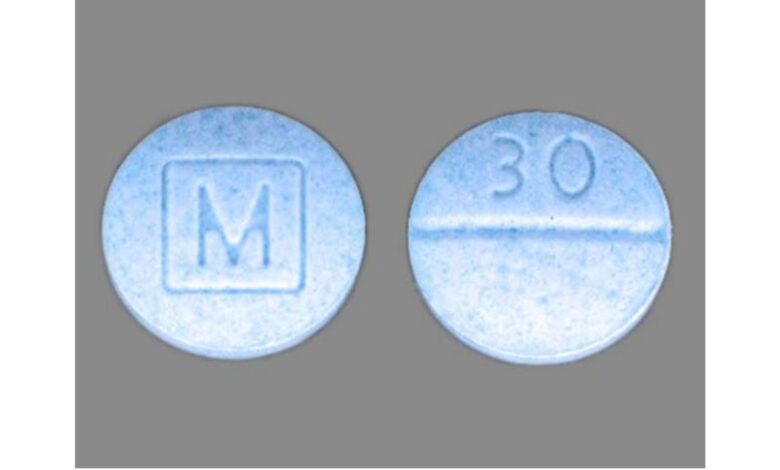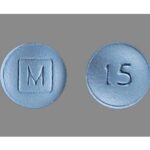What Are M30 Round Blue Pills?

The round blue pills with the imprint 30 M has been identified as Oxycodone Hydrochloride 30 mg supplied by Mallinckrodt Pharmaceuticals. Oxycodone is used in the treatment of chronic pain and belongs to a class of drugs called opioid agonists. A class of drugs is a group of medications that work in a similar way. These drugs are often used to treat similar conditions.
Oxycodone is similar to a group of natural substances in the brain called endorphins. These substances work to decrease the pain messages that your body sends to your brain. By mimicking these substances, M 30 pill decreases the amount of pain your brain thinks you’re having. Oxycodone (M 30 pill) is a DEA controlled drug and a DEA Schedule II controlled substance. Substances in the DEA Schedule II have a high potential for abuse which may lead to severe psychological or physical dependence. Oxycodone is classified by the DEA as a Narcotics (Opioids) drug. Street names for Oxycodone are Hillbilly Heroin, Kicker, OC, Ox, Roxy, Perc, and Oxy.
Why is M 30 pill prescribed?
M 30 pill is used to relieve moderate to severe pain. Oxycodone extended-release tablets and extended-release capsules are used to relieve severe pain in people who are expected to need pain medication around the clock for a long time and who cannot be treated with other medications.
How should this medicine be used?
M 30 pill is a prescription medicine and should never be used without the supervision of a qualified medical personnel. A prescription drug is a pharmaceutical drug that legally requires a medical prescription to be dispensed. Follow the directions on your prescription label carefully, and ask your doctor or pharmacist to explain any part you do not understand. Take oxycodone exactly as directed.
Your doctor will likely start you on a low dose of oxycodone and may increase this dose over time if your pain is not controlled. After you take oxycodone for a period of time, your body may become used to the medication. If this happens, your doctor may need to increase your dose to control your pain. Your doctor may decrease your dose if you experience side effects. Talk to your doctor about how you are feeling during your treatment with oxycodone.
Do not stop taking M 30 pill without talking to your doctor. If you stop taking this medication suddenly, you may experience withdrawal symptoms such as restlessness, watery eyes, runny nose, sneezing, yawning, sweating, chills, muscle or joint aches or pains, weakness, irritability, anxiety, depression, difficulty falling asleep or staying asleep, cramps, nausea, vomiting, diarrhea, loss of appetite, fast heartbeat, and fast breathing. Your doctor will probably decrease your dose gradually.
What side effects M 30 blue pill cause?
M 30 pill may cause side effects. Tell your doctor if any of these symptoms are severe or do not go away:
- dry mouth
- stomach pain
- drowsiness
- flushing
- headache
- mood changes
Some side effects can be serious. If you experience any of these symptoms call your doctor immediately or get emergency medical help:
- changes in heartbeat
- agitation, hallucinations (seeing things or hearing voices that do not exist), fever, sweating, confusion, fast heartbeat, shivering, severe muscle stiffness or twitching, loss of coordination, nausea, vomiting, or diarrhea
- nausea, vomiting, loss of appetite, weakness, or dizziness
- inability to get or keep an erection
- irregular menstruation
- decreased sexual desire
- chest pain
- hives
- itching
- rash
- swelling of the face, throat, tongue, lips, eyes, hands, feet, ankles, or lower legs
- hoarseness
- difficulty breathing or swallowing
- seizures
- extreme drowsiness
- lightheadedness when changing positions
M 30 Pill Safety Information
The M 30 blue pill contains Oxycodone which can be habit-forming. Take oxycodone exactly as directed. Do not take more of it, take it more often, or take it in a different way than directed by your doctor. While taking oxycodone, discuss with your healthcare provider your pain treatment goals, length of treatment, and other ways to manage your pain. Tell your doctor if you or anyone in your family drinks or has ever drunk large amounts of alcohol, uses or has ever used street drugs, or has overused prescription medications, or has had an overdose, or if you have or have ever had depression or another mental illness. There is a greater risk that you will overuse M 30 pill if you have or have ever had any of these conditions. Talk to your healthcare provider immediately and ask for guidance if you think that you have an opioid addiction or call the U.S. Substance Abuse and Mental Health Services Administration (SAMHSA) National Helpline at 1-800-662-HELP.
Oxycodone may cause serious or life-threatening breathing problems, especially during the first 24 to 72 hours of your treatment and any time your dose is increased. Your doctor will monitor you carefully during your treatment. Tell your doctor if you have or have ever had slowed breathing or asthma. Your doctor will probably tell you not to take oxycodone. Also tell your doctor if you have or have ever had lung disease such as chronic obstructive pulmonary disease (COPD; a group of diseases that affect the lungs and airways), a head injury a brain tumor, or any condition that increases the amount of pressure in your brain. The risk that you will develop breathing problems may be higher if you are an older adult or are weak or malnourished due to disease. If you experience any of the following symptoms, call your doctor immediately or get emergency medical treatment: slowed breathing, long pauses between breaths, or shortness of breath.
Taking certain other medications with oxycodone may increase the risk of serious or life-threatening breathing problems, sedation, or coma. Tell your doctor and pharmacist if you are taking or plan to take any of the following medications: certain antibiotics such as clarithromycin (Biaxin, in PrevPac) and erythromycin (Erytab, Erythrocin); certain antifungal medications including itraconazole (Onmel, Sporanox), ketoconazole (Nizoral), and voriconazole (Vfend); benzodiazepines such as alprazolam (Xanax), chlordiazepoxide (Librium), clonazepam (Klonopin), diazepam (Diastat, Valium), estazolam, flurazepam, lorazepam (Ativan), oxazepam, temazepam (Restoril), and triazolam (Halcion); carbamazepine (Carbatrol, Epitol, Equetro, Tegretol, Teril); medications for mental illness, nausea or pain; muscle relaxants; certain medications for human immunodeficiency virus (HIV) including indinavir (Crixivan), nelfinavir (Viracept), and ritonavir (Norvir, in Kaletra); phenytoin (Dilantin, Phenytek); rifabutin (Mycobutin), rifampin (Rifadin, Rimactane, in Rifamate); sedatives; sleeping pills; or tranquilizers. Your doctor may need to change the doses of your medication and will monitor you carefully. If you take oxycodone with any of these medications and you develop any of the following symptoms, call your doctor immediately or seek emergency medical care: unusual dizziness, lightheadedness, extreme sleepiness, slowed or difficult breathing, or unresponsiveness. Be sure that your caregiver or family members know which symptoms may be serious so they can call the doctor or emergency medical care if you are unable to seek treatment on your own.
Drinking alcohol, taking prescription or nonprescription medications that contain alcohol, or using street drugs during your treatment with oxycodone increases the risk that you will experience serious, life-threatening side effects. Do not drink alcohol, take prescription or nonprescription medications that contain alcohol, or use street drugs during your treatment.
If you are taking the oxycodone extended-release tablets, swallow them whole; do not chew, break, divide, crush, or dissolve them. Do not presoak, lick or otherwise wet the tablet prior to placing in the mouth. Swallow each tablet right after you put it in your mouth. If you swallow broken, chewed, crushed, or dissolved extended-release tablets, you may receive too much oxycodone at once instead of slowly over 12 hours. This may cause serious problems, including overdose and death.
Oxycodone comes as a regular solution (liquid) and as a concentrated solution that contains more oxycodone in each milliliter of solution. Be sure that you know whether your doctor has prescribed the regular or concentrated solution and the dose in milliliters that your doctor has prescribed. Use the dosing cup, oral syringe, or dropper provided with your medication to carefully measure the number of milliliters of solution that your doctor prescribed. Read the directions that come with your medication carefully and ask your doctor or pharmacist if you have any questions about how to measure your dose or how much medication you should take. You may experience serious or life threatening side effects if you take an oxycodone solution with a different concentration or if you take a different amount of medication than prescribed by your doctor.
Do not allow anyone else to take your medication. Oxycodone may harm or cause death to other people who take your medication, especially children.
Store oxycodone in a safe place so that no one else can take it accidentally or on purpose. Be especially careful to keep oxycodone out of the reach of children. Keep track of how many tablets or capsules, or how much liquid is left so you will know if any medication is missing. Dispose of unwanted capsules, tablets, extended-release tablets, extended-release capsules, and liquid properly according to instructions. (See STORAGE and DISPOSAL).
Tell your doctor if you are pregnant or plan to become pregnant. If you take oxycodone regularly during your pregnancy, your baby may experience life-threatening withdrawal symptoms after birth. Tell your baby’s doctor right away if your baby experiences any of the following symptoms: irritability, hyperactivity, abnormal sleep, high-pitched cry, uncontrollable shaking of a part of the body, vomiting, diarrhea, or failure to gain weight.
Talk to your doctor about the risks of taking oxycodone.
Your doctor or pharmacist will give you the manufacturer’s patient information sheet (Medication Guide) when you begin your treatment with oxycodone and each time you fill your prescription. Read the information carefully and ask your doctor or pharmacist if you have any questions. You can also visit the Food and Drug Administration (FDA) website (http://www.fda.gov/Drugs/DrugSafety/ucm085729.htm) or the manufacturer’s website to obtain the Medication Guide. You Can Find More Information On: How to Spot Fake Oxycodone M 30 Pills





